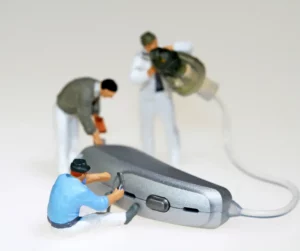When to Seek Professional Hearing Aid Repairs

At Stanford Hearing, we’re dedicated to simplifying the complexities of hearing aid repairs and ensuring you have access to the best possible care for your hearing devices. This comprehensive guide is crafted to empower you with knowledge and practical solutions for at-home hearing aid maintenance. Also, we want to help you identify when you need hearing aid repair near me.
Hearing Aid Repairs at Home
Addressing common hearing aid issues at home is often straightforward. Here’s what you can do to fix hearing aids yourself:
For low or no sound:
- Ensure batteries are fresh and properly installed.
- Check that the battery door is securely closed on disposable models.
- Confirm the charge is full-on rechargeable models.
To resolve feedback or whistling:
- Clean the earmold or receiver tube to eliminate wax or debris.
- Ensure BTE earmolds fit well and ITC or ITE models aren’t inserted too deeply.
For poor or muffled sound quality:
- Remove any wax from the earmold or receiver tube.
- Adjust the volume control and check the fit of your device.
If you’re experiencing discomfort:
- Adjust the fit of your earmold or earplug.
- Ensure BTE earmolds are not too tight and ITC or ITE models are sized correctly.
To inspect for blockages:
- Examine your hearing aids in good lighting.
- Check for wax near the microphone or sound outlet and assess BTE tubing for damage.
Additional at-home ways to fix hearing aids:
- Turn your hearing aids off and on.
- Reinsert your devices carefully.
- Consider getting refitted if there have been changes to your ears or weight.
Discover more about hearing aid maintenance.
Managing Water Damage
To prevent hearing aid repairs due to moisture:
- Air out your hearing aids nightly by opening the battery compartment.
- Use a dehumidifier and consider a hearing aid sleeve in humid conditions.
- Remove your hearing aids before water exposure.
To fix hearing aids after water exposure:
- Immediately turn off the device and remove the battery.
- Dry the hearing aid gently and use a dehumidifier to aid the drying process.

Battery Maintenance Tips
Prolong battery life by:
- Lowering the volume and limiting audio streaming.
- Storing hearing aids in a cool, dry place.
- Regularly cleaning your devices.
- For rechargeable models, adhere strictly to the charging guidelines provided.
Explore more in our rechargeable hearing aids guide.
Successfully managing common hearing aid issues at home can significantly enhance the longevity and performance of your device. In fact, you can tackle problems like low sound, feedback, discomfort, and moisture by following the steps provided. Regular battery maintenance is equally crucial to ensure your hearing aids are always ready when you need them. However, there are instances where an issue may surpass the scope of at-home remedies and require a professional touch. In the following section, we’ll explore when it’s appropriate to seek professional help to fix hearing aids, ensuring you have the knowledge to decide when expert intervention is necessary for the health of your hearing aids.
When It’s Time to Seek Professional Repair Services
Consult a professional if:
- Home troubleshooting proves ineffective.
- You experience persistent feedback or whistling.
- Physical damage to your hearing aids is apparent.
- Batteries deplete unusually quickly.
Stanford Hearing’s professionals can manage complex repairs, often on-site, reducing the time you are without your hearing aids. If manufacturer repairs are necessary, we will assist with timelines.
Locating Reliable Repair Services
When seeking local hearing aid repairs, you should:
- Ask for referrals from hearing care professionals.
- Read online reviews for insights on reliability and quality.
- Compare quotes and confirm the repair shop’s certification and experience.
- Be cautious of services offering free repairs or lacking warranties, and always request a written agreement detailing the repair costs and terms.
Understanding Warranties and Repair Policies
Warranties usually cover manufacturing defects for up to three years, with options for extended coverage. Additionally, be aware of what is and isn’t included, and maintain regular service to get the most out of your warranty. In the event of out-of-warranty repairs, Stanford Hearing can provide certified hearing aid repair and maintenance.

Choosing Stanford Hearing for Hearing Aid Repair Near Me
So when the frequency and cost of repairs become burdensome, it may be time to consider a new hearing aid. At Stanford Hearing, we offer the latest hearing technologies and personalized service to enhance your auditory experience. Our experts are at your service to provide both repair and upgrade options, ensuring your hearing aids function optimally. We invite you to schedule an appointment with us to explore your hearing aid repairs or replacement options and start your journey to better hearing. Contact Stanford Hearing today and take the first step toward a clearer sound experience.
